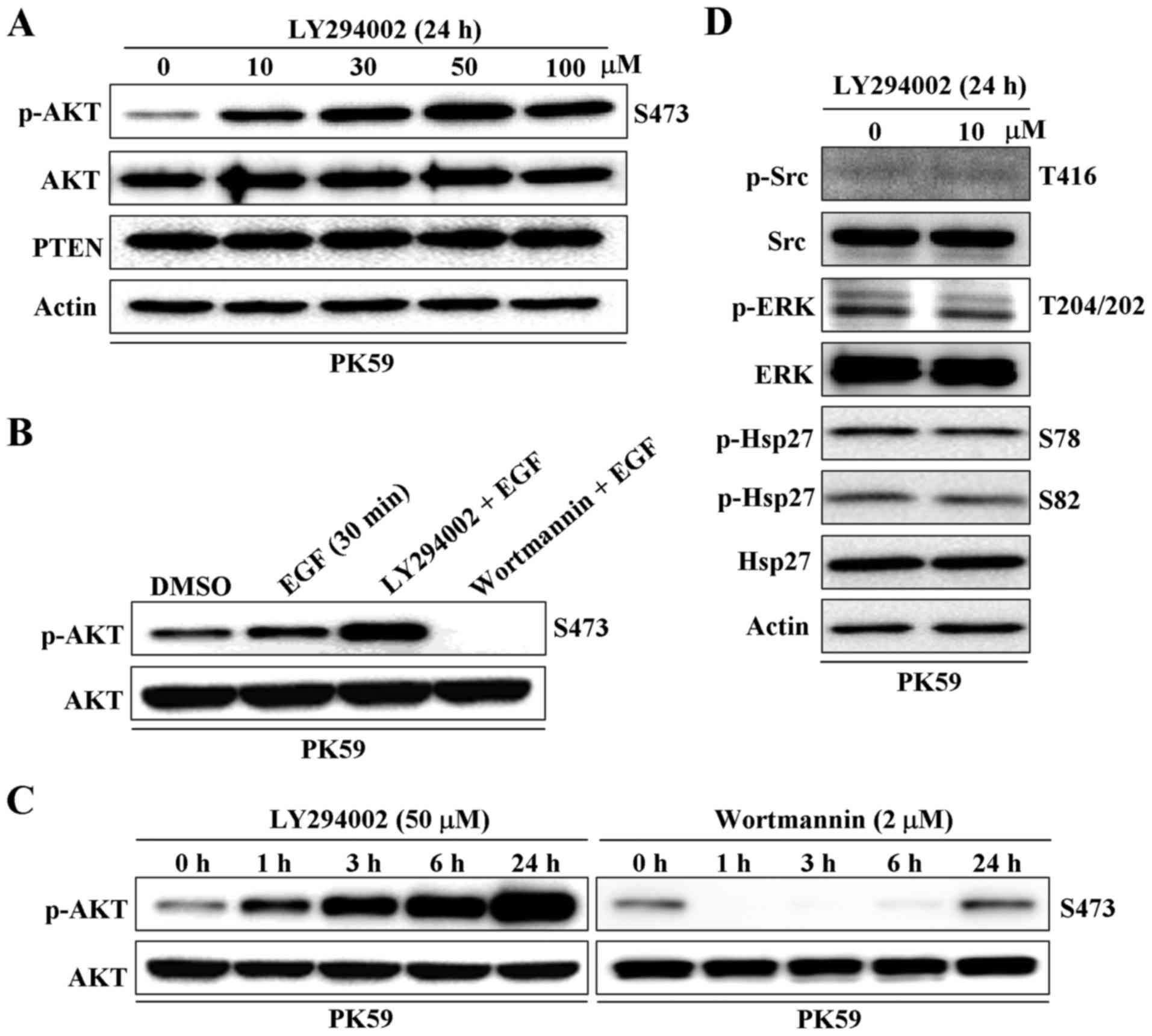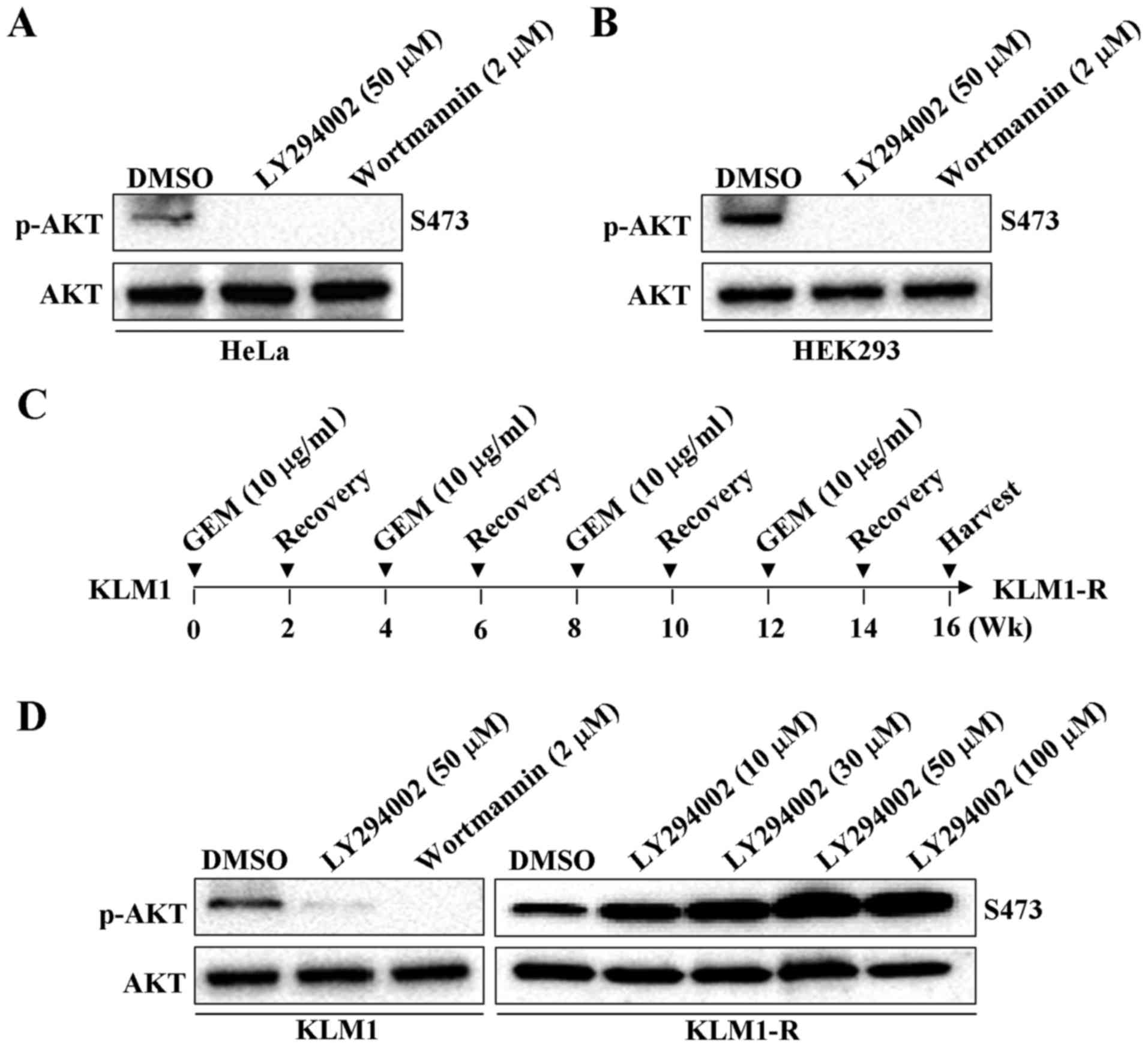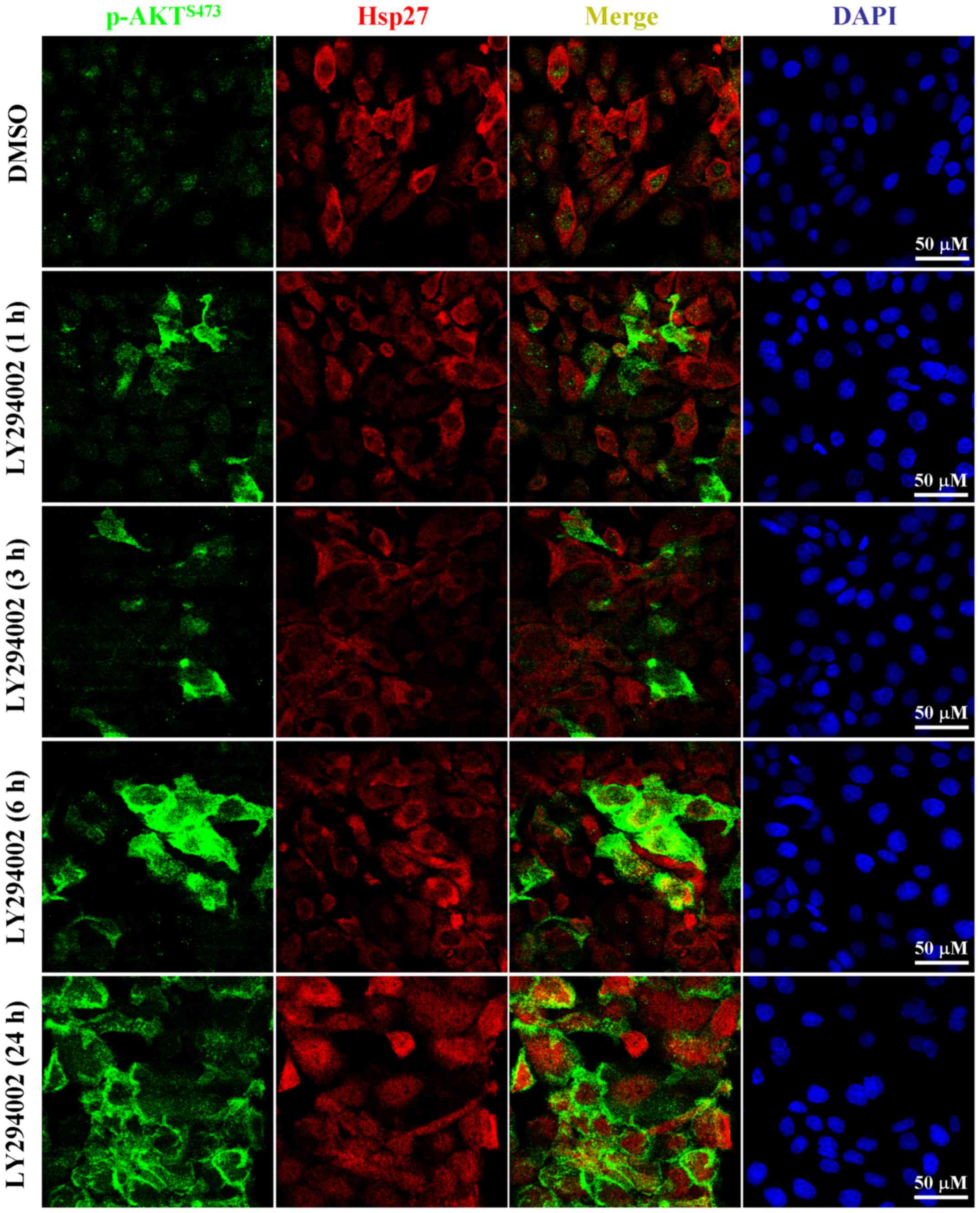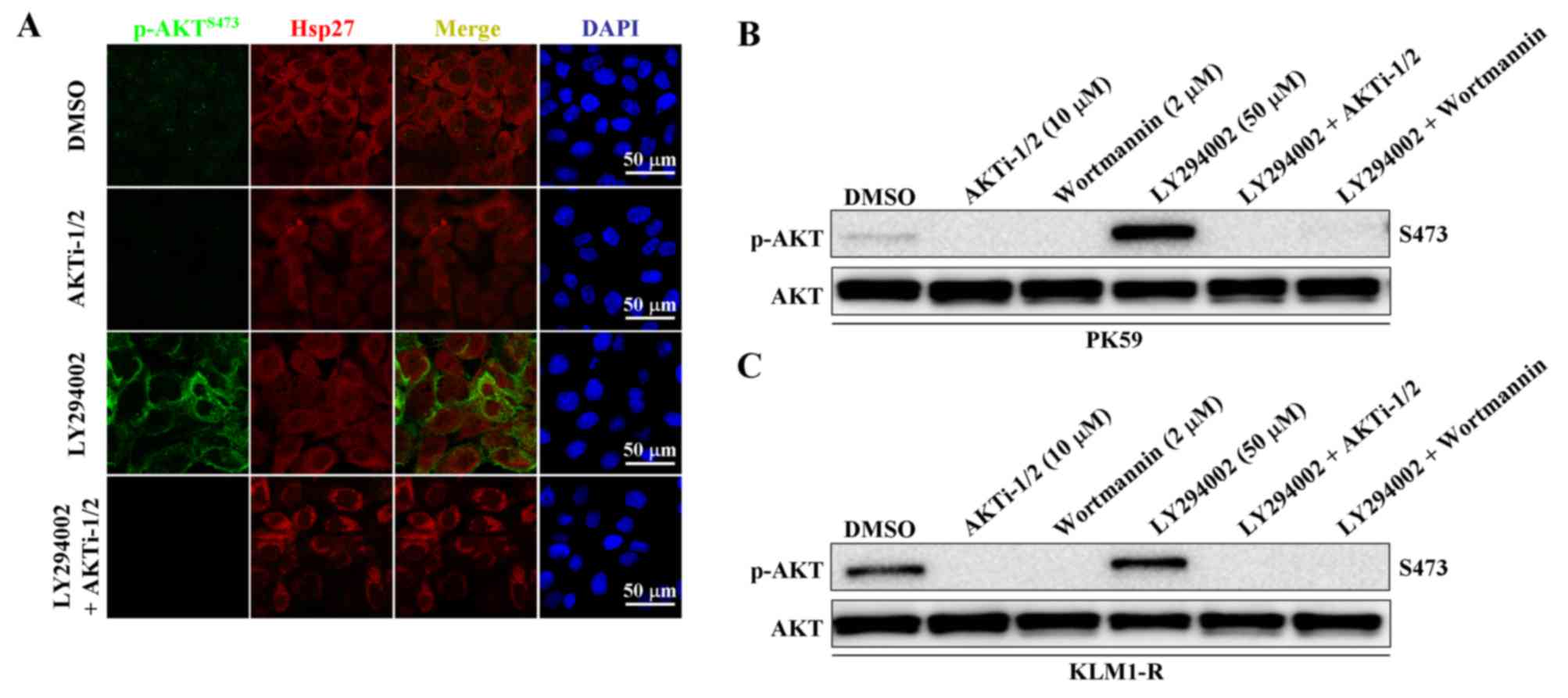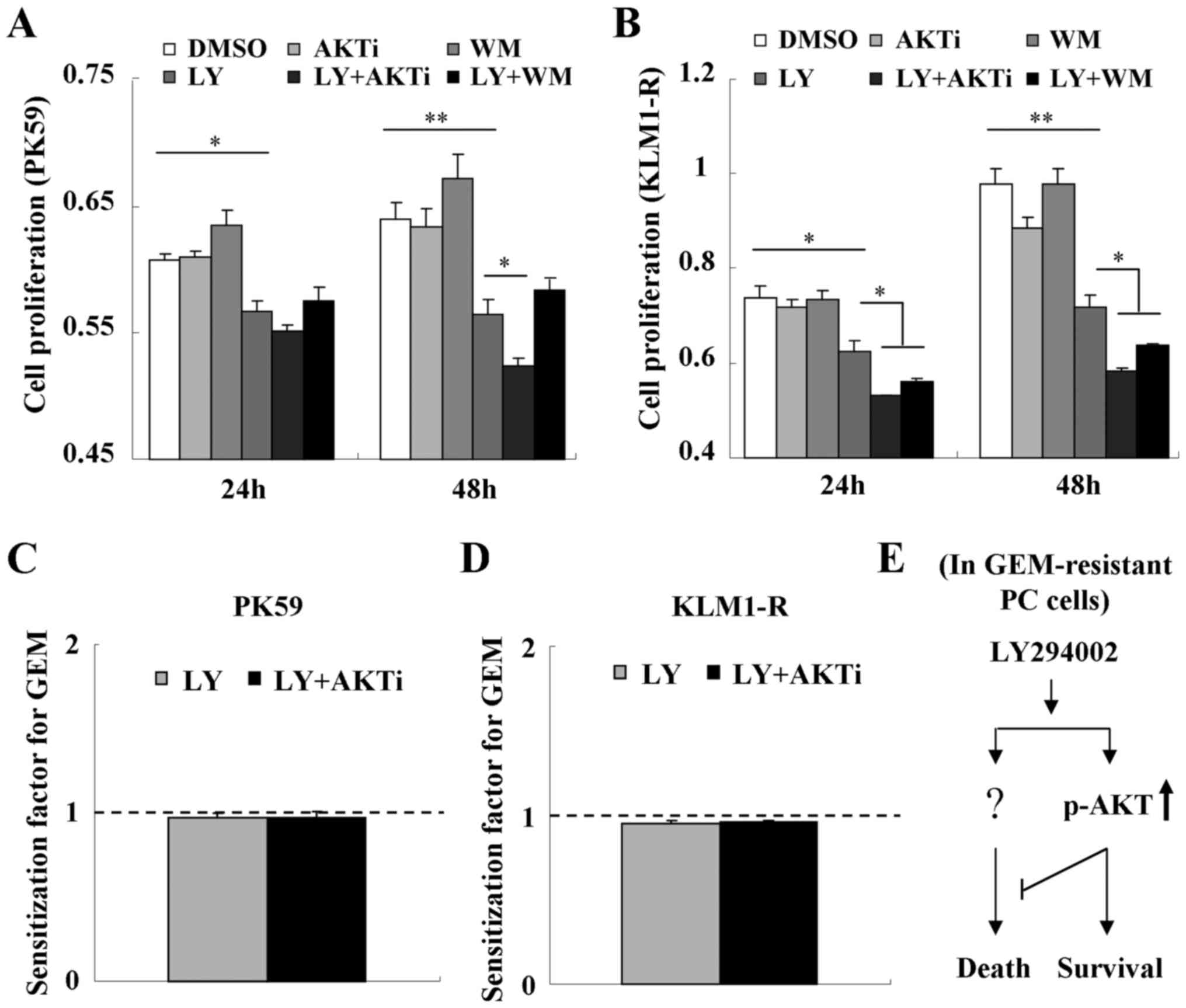PI3K inhibitor LY294002, as opposed to wortmannin, enhances AKT phosphorylation in gemcitabine-resistant pancreatic cancer cells
- Authors:
- Published online on: December 14, 2016 https://doi.org/10.3892/ijo.2016.3804
- Pages: 606-612
Abstract
Introduction
Phosphoinositide 3-kinases (PI3Ks) are a family of enzymes which are involved in cellular functions, such as cell growth, proliferation, differentiation and intracellular trafficking, which in turn contribute to cancer (1). Class IA PI3Ks, which consist of a regulatory subunit (p85) and a catalytic subunit (p110), are frequently mutated in human cancers and many of these mutations cause the kinases to become more active (2–5).
PI3Ks can be activated by growth factor stimulation, which results in the phosphorylation of phosphatidylinositol 4,5-bisphosphate (PIP2) to produce phosphatidylinositol 3,4,5-bisphosphate (PIP3) (6). PIP3 directly binds phosphoinositide-dependent kinase 1 (PDK1) and protein kinase B (AKT), causing the colocalization of activated PDK1 with AKT, which allows AKT phosphorylation on threonine 308 (T308) by PDK1 (7,8). Complete activation of AKT occurs by phosphorylation on serine 473 (S473) by mammalian target of rapamycin (mTOR)-containing protein complex 2 (mTORC2) (9). PI3K/AKT signaling is closely associated to cellular proliferation and survival through several mechanisms, such as inhibition of pro-apoptotic B-cell lymphoma 2 (Bcl-2) family members BAD and BAX, activation of transcription factor NF-κB, suppression of p53 by phosphorylating E3 ubiquitin-protein ligase (Mdm2) and promotion of protein synthesis by stimulating mTORC1 (6,10,11).
Because inhibition of PI3K signaling can diminish cell growth and promote cell death, targeting the PI3K signaling pathway by inhibitors is being evaluated in clinical trials for cancer therapeutics. Preclinical studies have shown that PI3K pathway inhibitors have remarkable curative effects in several types of cancer, such as human epidermal growth factor receptor 2 (HER2)-amplified breast cancers, cancers with PIK3CA mutations and phosphatase and tensin homolog (PTEN)-deficient cancers (12–14).
Several reports have shown that PI3K inhibitors could be used as adjuvant therapy for pancreatic cancer, as it improved the anticancer drug efficacy by inhibiting the PI3K pathway and extended the overall survival in mouse models (15–18). In this study, however, the PI3K inhibitor LY294002 has been shown to enhance PI3K-dependent AKT phosphorylation in pancreatic cancer cells. Interestingly, this phosphorylation induced by LY294002 only occurs once the cells have gained GEM-resistance. Moreover, inhibition of PI3K by treatment with wortmannin did not induce any apparent cytotoxicity in GEM-resistant cells. Our data indicate that the uncertainty and risk is still high for treating PC by using PI3K inhibitors.
Materials and methods
Cell lines
All cell lines were obtained from Cell Resource Center for Biomedical Research Institute of Development, Aging and Cancer, Tohoku University. Cells were cultured in Roswell Park Memorial Institute-1640 (RPMI-1640; Gibco, 05918, Gaithersburg, MD, USA) medium supplemented with 10% heat-inactivated fetal bovine serum (FBS; Gibco, 26140-079) and 21 mM of L-glutamine, at 37°C, in a humidified 5% CO2-95% air mixture. GEM-resistant cells derived from KLM1 (KLM1-R) was established as previous descriptions (19,20). KLM1 cells were tretaed with 10 µg/ml of GEM for 2 weeks, after which, cells were washed and resuspended in fresh medium. This was followed by a 2-week culture period which served as a recovery procedure. This procedure was repeated for another 3 cycles.
Materials
LY294002 (9901) and wortmannin (9951S) were purchased from Cell Signaling Technology (Boston, MA, USA). AKTi-1/2 (ab142088) was purchased from Abcam Biochemicals (Cambridge, MA, USA). Epithelial growth factor (E9644) was purchased from Sigma (St. Louis, MO, USA). The antibodies specific for p-ERKT204/202 (sc-7383), ERK (sc-94200), Hsp27 (sc-13132) and actin (sc-1616) were purchased from Santa Cruz Biotechnology (Santa Cruz, CA, USA). The antibodies specific for Src (Src Antibody Sampler kit, 9935), p-Hsp27S78 (2405), p-Hsp27S82 (2401), PTEN (9552S), AKT (9272) and p-AKTS473 (4058) were purchased from Cell Signaling Technology.
Western blotting
Total protein was extracted from the cells using lysis buffer (1% NP-40, 1 mM sodium vanadate, 11 mM PMSF, 501 mM Tris, 101 mM NaF, 101 mM EDTA, 1651 mM NaCl, 10 µg/ml leupeptin, and 10 µg/ml aprotinin) (21). Equal amounts of protein (20 µg) were resolved by 5–20% SDS-polyacrylamide gel and then transferred onto PVDF membrane (Immobilon-P; Millipore, Bedford, MA, USA). The membrane was incubated with a primary antibody at 4°C overnight and a horseradish peroxidase (HRP)-conjugated secondary antibody for 1 h at room temperature. The immunoblots were visualized with a chemiluminescent reagent (Immunostar, Wako, Osaka, Japan) and detected by using an Image Reader LAS-1000 Pro (Fujifilm Corp., Tokyo, Japan).
Immunofluorescence
Cells were cultured on coverslips in 12-well plates at a density of 1×105 cells per well. Cells were fixed using fresh 3.7% paraformaldehyde in phosphate-buffered saline (PBS) and permeabilized with 0.1% Triton X-100. After washing with PBS they were incubated in blocking solution (1% goat serum or 1% donkey serum in PBS with 0.1% Tween-20) for 1 h at room temperature (22). Cells were treated with a primary antibody in blocking solution overnight at 4°C and a secondary antibody for 1 h at room temperature. Cell nuclei were counter-stained with 1.43 µM DAPI (4,6′-diamidino-2-phenylindole). Confocal images were obtained by using Laser Scan Confocal Microscope (LSM 510 META; Carl Zeiss, Mobicity, Australia).
Cell proliferation assay
Cells were cultured in 96-well plates. After treatment, 20 µl of the 3-(4,5-dimethylthiazol-2-yl)-5(3-carboxymethonyphenol)-2-(4-sulfophenyl)-2H-tetrazolium (MTS) dye (Promega, Madison, WI, USA) was added to each well of the plate and incubated for 2 h at 37°C, in a humidified 5% CO2-95% air mixture. Optical density (OD) was read directly at 492 nm using the iMark™ microplate absorbance reader (Bio-Rad, Hercules, CA, USA). Each experiment was repeated three times.
Results
The PI3K inhibitor LY294002 (but not wortmannin) enhances AKT phosphorylation in PK59 cells
The effect of the PI3K inhibitor, LY294002, on AKT phosphorylation at serine 473 in PC PK59 cells was detected by western blot analysis. Unexpectedly, p-AKT was significantly increased rather than decreased by treatment with LY294002 for 24 h in a dose-dependent manner and over a time course (Fig. 1A and C). LY294002 was also shown to enhance epithelial growth factor (EGF)-triggered AKT phosphorylation (Fig. 1B). However, the other PI3K inhibitor, wortmannin, showed the expected performance in inhibiting the PI3K/AKT pathway (Fig. 1B and C). Interestingly, the effect of wortmannin on inhibiting AKT phosphorylation was weakened after 6 h of treatment and completely disappeared after 24 h (Fig. 1C). In addition, the phosphorylation of tyrosine-protein kinase CSK (Src), extracellular regulated protein kinases (ERK) and heat shock protein 27 (Hsp27), which have been shown to be involved in AKT activation (23–26), were not altered by treatment with LY294002 (Fig. 1D). These results indicate that LY294002, but not wortmannin, displays the opposite function to that expected in regulating the PI3K/AKT signaling pathway in PK59 cells.
LY294002-induced AKT phosphorylation specifically occurs in GEM-resistant PC cells
LY294002, as well as wortmannin, have shown their ability to inhibit PI3K/AKT activity in HeLa and HEK293 cells (Fig. 2A and B). LY294002 could also inhibit AKT phosphorylation in various types of PC cancer cell lines, such as in Panc-1, MIA-PaCa-2, AsPC-1 and BxPC-3 cells (27–29). We previously reported that PK59 is much less sensitive to GEM (IC50, 294.72 µg/ml) than Panc-1 (IC50, 8.07 µg/ml), MIA-PaCa-2 (IC50, 6.81 µg/ml), AsPC-1 (IC50, 1.05 µg/ml) or BxPC-3 (IC50, 6.67 µg/ml) cells (30). We thus tested whether LY294002-induced AKT phosphorylation specifically occurs in GEM-resistant PC cells. A GEM-resistant PC cell line KLM1-R has been established by culturing the gemcitabine-sensitive KLM1 cells with 10 µg/ml of GEM (19,20), as shown (Fig. 2C). As hypothesized, upregulation of p-AKT instead of downregulation was observed by treatment with LY294002 in GEM-resistant KLM1-R compared to KLM1 cells in a dose-dependent manner (Fig. 2D). These results suggest that the inhibiting ability of LY294002 on PI3K could be altered in PC, once cells acquire GEM-resistance. PI3K activity is required for the LY294002-induced AKT phosphorylation and associated intracellular membrane translocation.
Using immunofluorescent analysis, p-AKT could only be observed in the nuclei of untreated PK59 cells (Fig. 3). However, AKT phosphorylation was initiated in the cytoplasm of LY294002-treated cells and the p-AKT eventually translocated onto the intracellular membrane after treatment for 24 h (Fig. 3), indicating that the LY294002-induced p-AKT may have functions associated with this specific localization. This kind of phosphorylation and intracellular membrane translocation of AKT could be abolished by combined treatment with an AKT specific inhibitor, AKTi-1/2 (Fig. 4A). We next examined whether LY294002-induced AKT phosphorylation is mediated by PI3K. Following treatment with LY294002 alone, p-AKT was significantly upregulated, but following combined treatment with LY294002 and either AKTi-1/2 or wortmannin, p-AKT was completely inhibited in both PK59 and KLM1-R cells (Fig. 4B and C). These data reveal that LY294002-induced AKT phosphorylation and intracellular membrane translocation are still dependent on PI3K.
LY294002-induced AKT phosphorylation contributes to cell survival
We next assessed the role of LY294002-induced p-AKT in cell proliferation. Treatment with wortmannin was shown to increase or have no effect on cell proliferation in PK59 and KLM1-R cells, respectively (Fig. 5A and B), indicating that GEM-resistant PC cells may also be resistant to the inhibitor of PI3K. Treatment with LY294002 alone significantly inhibited cell proliferation in PK59 and KLM1-R cells and this inhibition could be further enhanced by combined treatment with either AKTi-1/2 or wortmannin (Fig. 5A and B). These results indicate that LY294002-induced p-AKT plays a negative role in LY294002-triggered cytotoxicity in GEM-resistant PC cells. In addition, LY294002-induced p-AKT did not contribute to reducing the sensitivity of PK59 or KLM1-R cells to GEM (Fig. 5C and D).
Discussion
LY294002 is a synthetic compound that was designed as a PI3K inhibitor based on the flavonoid quercetin (31). Like most other protein kinase inhibitors, the mode of action of LY294002 is through competition with ATP for binding the PI3K active site (32). However, while quercetin is a broad-spectrum protein kinase inhibitor, LY294002 acts as a specific inhibitor for PI3K, with no inhibitory effect on other protein kinases such as the AMP-dependent protein kinase and c-Src (at a concentration of 50 mM) (31). Apart from PI3K, LY294002 has been shown to inhibit several key signaling components, such as NF-κB (33), heat shock proteins 27 (HSP27) and 72 (HSP72), AKT phosphorylation and survivin (34).
Interestingly, LY294002 binds PI3K in a different orientation to quercetin by a 180° rotation. When binding PI3K, LY294002 only occupies part of the active site of the catalytic domain, filling the space occupied by the ribose of the ATP molecule, without extending into the phosphate binding region. In comparison, wortmannin almost completely fits the active site of the catalytic domain of PI3K, inducing a fairly large conformational rearrangement. Moreover, wortmannin forms a covalent complex, which irreversibly inhibits PI3K (35). The covalently-linked complex is the reason why in this study a decrease in wortmannin activity over time was observed, as the irriversibly bound complex was degraded and free PI3K was replenished.
LY294002 is a promising therapeutic compound because it showed growth inhibitory effects on various types of cancer cells through the induction of apoptosis and cell cycle arrest or autophagy (36,37). Apoptotic cell death by LY294002 is mainly driven via activation of AMPKα1 and inactivation of AKT (38), but can also be via NF-κB (33). However, it can also act by reducing transforming growth factor β (TGFβ)-mediated epithelial to mesenchymal transition (EMT) (39), inhibiting fatty acid synthase or suppress metastasis (40,41).
The available literature for the combinatorial treatment of pancreatic cancer by LY294002 and gemcitabine is plentiful. In pancreatic cancer cells, partial reversal of the EMT was accompanied by inhibition of cell invasion and migration as well as increased chemosensitivity to GEM, and the process was mediated by the phosphatidylinositol 3-kinase (PTEN)/Akt signaling pathway (42). However, no importance appears to have been previously given to the effect of GEM-resistance to such treatment. The same can be said for most other flavonoids tested. One exception has been the treatment of GEM-resistant cell lines with GEM and apigenin (an isoconformer of the isoflavonoid genistein), which showed additive inhibition of cell proliferation compared to the use of either agent alone, via increased cell cycle arrest (at both the S and G2/M phases) as well as early apoptosis (by downregulation of pAkt) (43).
In conclusion, this is the first report to show that treatment of the GEM-resistant pancreatic cancer cell line PK59 with LY294002 (but not wortmannin) enhanced AKT phosphorylation specifically via PI3K and resulted in an associated translocation to the cell membrane. The overall effect of this LY294002-induced AKT phosphorylation on PK59 cells was an increase in cell survival. This should be an eye-opener for future clinical trials where the GEM-sensitivity of the tumor is not known.
Abbreviations:
|
PC |
pancreatic cancer |
|
PI3K |
phosphoinositide 3-kinase |
|
AKT |
protein kinase B |
|
GEM |
gemcitabine |
Acknowledgments
This study was supported in part by Grants-in-Aid from the Ministry of Education, Science, Sports, and Culture of Japan (no. 24501352 to Yasuhiro Kuramitsu). Immunoblot detection by LAS-1000 was done at the Gene Research Centre of Yamaguchi University.
References
|
Yuan TL and Cantley LC: PI3K pathway alterations in cancer: Variations on a theme. Oncogene. 27:5497–5510. 2008. View Article : Google Scholar : PubMed/NCBI | |
|
Ikenoue T, Kanai F, Hikiba Y, Obata T, Tanaka Y, Imamura J, Ohta M, Jazag A, Guleng B, Tateishi K, et al: Functional analysis of PIK3CA gene mutations in human colorectal cancer. Cancer Res. 65:4562–4567. 2005. View Article : Google Scholar : PubMed/NCBI | |
|
Mizoguchi M, Nutt CL, Mohapatra G and Louis DN: Genetic alterations of phosphoinositide 3-kinase subunit genes in human glioblastomas. Brain Pathol. 14:372–377. 2004. View Article : Google Scholar : PubMed/NCBI | |
|
Samuels Y and Velculescu VE: Oncogenic mutations of PIK3CA in human cancers. Cell Cycle. 3:1221–1224. 2004. View Article : Google Scholar : PubMed/NCBI | |
|
Philp AJ, Campbell IG, Leet C, Vincan E, Rockman SP, Whitehead RH, Thomas RJ and Phillips WA: The phosphatidylinositol 3′-kinase p85alpha gene is an oncogene in human ovarian and colon tumors. Cancer Res. 61:7426–7429. 2001.PubMed/NCBI | |
|
Cantley LC: The phosphoinositide 3-kinase pathway. Science. 296:1655–1657. 2002. View Article : Google Scholar : PubMed/NCBI | |
|
Alessi DR, James SR, Downes CP, Holmes AB, Gaffney PR, Reese CB and Cohen P: Characterization of a 3-phosphoinositide-dependent protein kinase which phosphorylates and activates protein kinase Balpha. Curr Biol. 7:261–269. 1997. View Article : Google Scholar : PubMed/NCBI | |
|
Currie RA, Walker KS, Gray A, Deak M, Casamayor A, Downes CP, Cohen P, Alessi DR and Lucocq J: Role of phosphatidylinositol 3,4,5-trisphosphate in regulating the activity and localization of 3-phosphoinositide-dependent protein kinase-1. Biochem J. 337:575–583. 1999. View Article : Google Scholar : PubMed/NCBI | |
|
Sarbassov DD, Guertin DA, Ali SM and Sabatini DM: Phosphorylation and regulation of Akt/PKB by the rictor-mTOR complex. Science. 307:1098–1101. 2005. View Article : Google Scholar : PubMed/NCBI | |
|
Engelman JA, Luo J and Cantley LC: The evolution of phosphatidylinositol 3-kinases as regulators of growth and metabolism. Nat Rev Genet. 7:606–619. 2006. View Article : Google Scholar : PubMed/NCBI | |
|
Duronio V: The life of a cell: Apoptosis regulation by the PI3K/PKB pathway. Biochem J. 415:333–344. 2008. View Article : Google Scholar : PubMed/NCBI | |
|
Engelman JA, Chen L, Tan X, Crosby K, Guimaraes AR, Upadhyay R, Maira M, McNamara K, Perera SA, Song Y, et al: Effective use of PI3K and MEK inhibitors to treat mutant Kras G12D and PIK3CA H1047R murine lung cancers. Nat Med. 14:1351–1356. 2008. View Article : Google Scholar : PubMed/NCBI | |
|
Serra V, Markman B, Scaltriti M, Eichhorn PJ, Valero V, Guzman M, Botero ML, Llonch E, Atzori F, Di Cosimo S, et al: NVP-BEZ235, a dual PI3K/mTOR inhibitor, prevents PI3K signaling and inhibits the growth of cancer cells with activating PI3K mutations. Cancer Res. 68:8022–8030. 2008. View Article : Google Scholar : PubMed/NCBI | |
|
She QB, Chandarlapaty S, Ye Q, Lobo J, Haskell KM, Leander KR, DeFeo-Jones D, Huber HE and Rosen N: Breast tumor cells with PI3K mutation or HER2 amplification are selectively addicted to Akt signaling. PLoS One. 3:e30652008. View Article : Google Scholar : PubMed/NCBI | |
|
Junttila MR, Devasthali V, Cheng JH, Castillo J, Metcalfe C, Clermont AC, Otter DD, Chan E, Bou-Reslan H, Cao T, et al: Modeling targeted inhibition of MEK and PI3 kinase in human pancreatic cancer. Mol Cancer Ther. 14:40–47. 2015. View Article : Google Scholar | |
|
Duong HQ, Kim HJ, Kang HJ, Seong YS and Bae I: ZSTK474, a PI3K inhibitor, suppresses proliferation and sensitizes human pancreatic adenocarcinoma cells to gemcitabine. Oncol Rep. 27:182–188. 2012. | |
|
Jung KH, Yan HH, Fang Z, Son MK, Lee H, Hong S and Hong SS: HS-104, a PI3K inhibitor, enhances the anticancer efficacy of gemcitabine in pancreatic cancer. Int J Oncol. 45:311–321. 2014.PubMed/NCBI | |
|
Cruceru ML, Enciu AM, Popa AC, Albulescu R, Neagu M, Tanase CP and Constantinescu SN: Signal transduction molecule patterns indicating potential glioblastoma therapy approaches. Onco Targets Ther. 6:1737–1749. 2013.PubMed/NCBI | |
|
Iwasaki I, Sugiyama H, Kanazawa S and Hemmi H: Establishment of cisplatin-resistant variants of human neuroblastoma cell lines, TGW and GOTO, and their drug cross-resistance profiles. Cancer Chemother Pharmacol. 49:438–444. 2002. View Article : Google Scholar : PubMed/NCBI | |
|
Maehara S, Tanaka S, Shimada M, Shirabe K, Saito Y, Takahashi K and Maehara Y: Selenoprotein P, as a predictor for evaluating gemcitabine resistance in human pancreatic cancer cells. Int J Cancer. 112:184–189. 2004. View Article : Google Scholar : PubMed/NCBI | |
|
Wang Y, Kuramitsu Y, Tokuda K, Okada F, Baron B, Akada J, Kitagawa T and Nakamura K: Proteomic analysis indicates that overexpression and nuclear translocation of lactoylglutathione lyase (GLO1) is associated with tumor progression in murine fibrosarcoma. Electrophoresis. 35:2195–2202. 2014.PubMed/NCBI | |
|
Wang Y, Kuramitsu Y, Tokuda K, Baron B, Kitagawa T, Akada J, Maehara S, Maehara Y and Nakamura K: Gemcitabine induces poly (ADP-ribose) polymerase-1 (PARP-1) degradation through autophagy in pancreatic cancer. PLoS One. 9:e1090762014. View Article : Google Scholar : PubMed/NCBI | |
|
Choudhury GG, Mahimainathan L, Das F, Venkatesan B and Ghosh-Choudhury N: c-Src couples PI 3 kinase/Akt and MAPK signaling to PDGF-induced DNA synthesis in mesangial cells. Cell Signal. 18:1854–1864. 2006. View Article : Google Scholar : PubMed/NCBI | |
|
Moelling K, Schad K, Bosse M, Zimmermann S and Schweneker M: Regulation of Raf-Akt cross-talk. J Biol Chem. 277:31099–31106. 2002. View Article : Google Scholar : PubMed/NCBI | |
|
Qi S, Xin Y, Qi Z, Xu Y, Diao Y, Lan L, Luo L and Yin Z: HSP27 phosphorylation modulates TRAIL-induced activation of Src-Akt/ERK signaling through interaction with β-arrestin2. Cell Signal. 26:594–602. 2014. View Article : Google Scholar | |
|
Zheng C, Lin Z, Zhao ZJ, Yang Y, Niu H and Shen X: MAPK-activated protein kinase-2 (MK2)-mediated formation and phosphorylation-regulated dissociation of the signal complex consisting of p38, MK2, Akt, and Hsp27. J Biol Chem. 281:37215–37226. 2006. View Article : Google Scholar : PubMed/NCBI | |
|
Singh S, Srivastava SK, Bhardwaj A, Owen LB and Singh AP: CXCL12-CXCR4 signalling axis confers gemcitabine resistance to pancreatic cancer cells: A novel target for therapy. Br J Cancer. 103:1671–1679. 2010. View Article : Google Scholar : PubMed/NCBI | |
|
Li W, Ma J, Ma Q, Li B, Han L, Liu J, Xu Q, Duan W, Yu S, Wang F, et al: Resveratrol inhibits the epithelial-mesenchymal transition of pancreatic cancer cells via suppression of the PI-3K/Akt/NF-κB pathway. Curr Med Chem. 20:4185–4194. 2013. View Article : Google Scholar | |
|
Fujiwara M, Izuishi K, Sano T, Hossain MA, Kimura S, Masaki T and Suzuki Y: Modulating effect of the PI3-kinase inhibitor LY294002 on cisplatin in human pancreatic cancer cells. J Exp Clin Cancer Res. 27:762008. View Article : Google Scholar : PubMed/NCBI | |
|
Mori-Iwamoto S, Kuramitsu Y, Ryozawa S, Taba K, Fujimoto M, Okita K, Nakamura K and Sakaida I: A proteomic profiling of gemcitabine resistance in pancreatic cancer cell lines. Mol Med Rep. 1:429–434. 2008.PubMed/NCBI | |
|
Vlahos CJ, Matter WF, Hui KY and Brown RF: A specific inhibitor of phosphatidylinositol 3-kinase, 2-(4-morpholinyl)-8-phenyl-4H-1-benzopyran-4-one (LY294002). J Biol Chem. 269:5241–5248. 1994.PubMed/NCBI | |
|
Toledo LM, Lydon NB and Elbaum D: The structure-based design of ATP-site directed protein kinase inhibitors. Curr Med Chem. 6:775–805. 1999.PubMed/NCBI | |
|
Grandage VL, Gale RE, Linch DC and Khwaja A: PI3-kinase/Akt is constitutively active in primary acute myeloid leukaemia cells and regulates survival and chemoresistance via NF-kappaB, Mapkinase and p53 pathways. Leukemia. 19:586–594. 2005.PubMed/NCBI | |
|
Ohnishi K, Yasumoto J, Takahashi A and Ohnishi T: LY294002, an inhibitor of PI-3K, enhances heat sensitivity independently of p53 status in human lung cancer cells. Int J Oncol. 29:249–253. 2006.PubMed/NCBI | |
|
Walker EH, Pacold ME, Perisic O, Stephens L, Hawkins PT, Wymann MP and Williams RL: Structural determinants of phosphoinositide 3-kinase inhibition by wortmannin, LY294002, quercetin, myricetin, and staurosporine. Mol Cell. 6:909–919. 2000. View Article : Google Scholar : PubMed/NCBI | |
|
Shtivelman E, Sussman J and Stokoe D: A role for PI 3-kinase and PKB activity in the G2/M phase of the cell cycle. Curr Biol. 12:919–924. 2002. View Article : Google Scholar : PubMed/NCBI | |
|
Xing C, Zhu B, Liu H, Yao H and Zhang L: Class I phosphatidylinositol 3-kinase inhibitor LY294002 activates autophagy and induces apoptosis through p53 pathway in gastric cancer cell line SGC7901. Acta Biochim Biophys Sin (Shanghai). 40:194–201. 2008. View Article : Google Scholar | |
|
Lee YK and Park OJ: Regulation of mutual inhibitory activities between AMPK and Akt with quercetin in MCF-7 breast cancer cells. Oncol Rep. 24:1493–1497. 2010.PubMed/NCBI | |
|
Bakin AV, Tomlinson AK, Bhowmick NA, Moses HL and Arteaga CL: Phosphatidylinositol 3-kinase function is required for transforming growth factor beta-mediated epithelial to mesenchymal transition and cell migration. J Biol Chem. 275:36803–36810. 2000. View Article : Google Scholar : PubMed/NCBI | |
|
Van de Sande T, De Schrijver E, Heyns W, Verhoeven G and Swinnen JV: Role of the phosphatidylinositol 3′-kinase/PTEN/Akt kinase pathway in the overexpression of fatty acid synthase in LNCaP prostate cancer cells. Cancer Res. 62:642–646. 2002.PubMed/NCBI | |
|
Cole GW Jr, Alleva AM, Zuo JT, Sehgal SS, Yeow WS, Schrump DS and Nguyen DM: Suppression of pro-metastasis phenotypes expression in malignant pleural mesothelioma by the PI3K inhibitor LY294002 or the MEK inhibitor UO126. Anticancer Res. 26A:809–821. 2006. | |
|
Yi XP, Han T, Li YX, Long XY and Li WZ: Simultaneous silencing of XIAP and survivin causes partial mesenchymal-epithelial transition of human pancreatic cancer cells via the PTEN/PI3K/Akt pathway. Mol Med Rep. 12:601–608. 2015.PubMed/NCBI | |
|
Strouch MJ, Milam BM, Melstrom LG, McGill JJ, Salabat MR, Ujiki MB, Ding XZ and Bentrem DJ: The flavonoid apigenin potentiates the growth inhibitory effects of gemcitabine and abrogates gemcitabine resistance in human pancreatic cancer cells. Pancreas. 38:409–415. 2009. View Article : Google Scholar : PubMed/NCBI |



